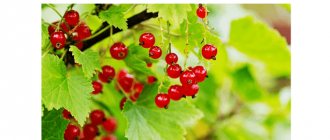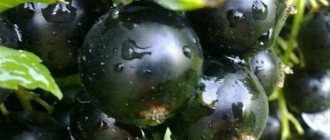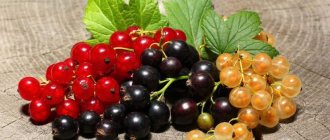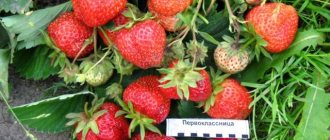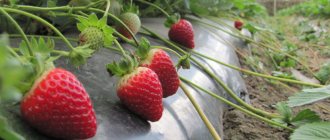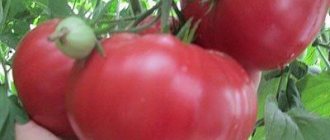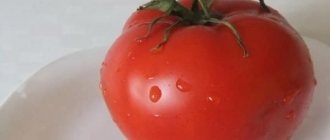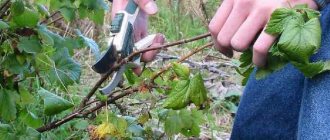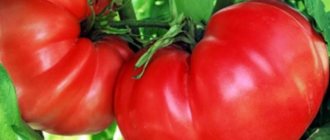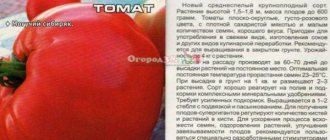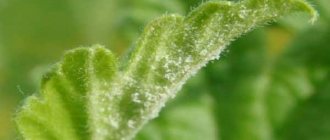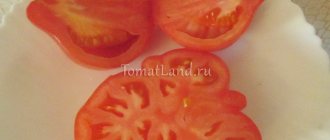Description of the variety
Black currant Dobrynya has an average ripening period. The bushes grow compact, with an average height of 150-170 cm. The shoots are not thick, straight, olive in color with a purple tint, shiny, but not very much, and have slight pubescence. The leaves are three-lobed, medium to large in size. The leaves are green in color, leathery and wrinkled. There are teeth along the edge. The flowers are large and pale yellow. The brushes are thick, green, and contain 6-10 flowers.
The berries are large, weighing 2.8-6 g, oval or round in shape. They are supported by thin, green stalks. The skin is shiny, black, dense. The pulp is dark red, with a high juice content. There are not many seeds, up to 6 in each berry. The taste is sweet with a slight sourness, with a pleasant aroma.
Important!
The yield of Dobrynya currant bushes after 5 years of development is greatly reduced. So they need to be regularly rejuvenated or replaced with young ones.
History of the variety
The author of the new currant variety is A. I. Astakhov, Doctor of Agricultural Sciences at the All-Russian Research Institute of Lupina. Thanks to the interspecific crossing of our own variety Izyumnaya and the linear hybrid 42-7, black currant Dobrynya was obtained. From the Izyumnaya variety, the new hybrid plant has adopted the sweetness of the fruit.
Dobrynya currant has been on the State Register since 2004. The plant was recommended for cultivation in central Russia and the south of Russia. But gradually the number of regions expanded. Today, bushes of this variety, according to reviews from gardeners, have taken their rightful place in plots in almost all regions of our country.
Characteristics of Dobrynya currant
Also check out these articles
- Description of the gooseberry variety Malachite
- Raspberry variety Maravilla
- How often and how to water flowers correctly
- Cabbage variety Nadezhda
Before purchasing Dobrynya currant bushes for planting on your site, it is worth finding out what its characteristics are.
- The variety is fast-growing, the bushes grow quickly. Already 2 years after planting, currants produce their first harvest.
- Thanks to the dense, elastic peel, the berries are suitable for long-term transportation.
- The taste of black currant Dobrynya is rated 4.8 points out of 5 possible. Contains about 7% sugars, titratable acidity 2.5%.
The berries are large, weighing 2.8-6 g, oval or round in shape
- The berries are large, beautiful, marketable.
- Winter hardiness is high. The bushes are not afraid of frosts down to -25 degrees.
- Resistance to spring frosts is average, as is resistance to drought.
- There is immunity to many diseases.
- Fruiting is extended.
- The yield is stable, 1.6-2.4 kg/season is harvested from each bush. This is approximately 10.6-16 tons per hectare.
Due to its qualities, currants of this variety are suitable not only for cultivation on private farms. It is often chosen for planting on large farms or even plantations. As for the berries, they are suitable for processing on a small and industrial scale.
Features of planting and growing the Dobrynya variety
There are few differences in the agricultural technology of growing Dobrynya. And they are explained mainly by the characteristics of the variety. Intensive varieties begin to bear fruit already in the second year after planting. They require good fertilization and regular pruning. At first only sanitary, and then rejuvenating. When industrially growing this variety, only one-year-old branches are often left when pruning. This makes it possible to obtain harvests from plants for 12 years or more. Perhaps some amateur gardener would like to conduct this experiment.
When planting, 4–5 kg of humus or good, mature compost and 1 glass of wood ash or any complex fertilizer according to the instructions are added to each hole. Subsequently, both organic and mineral fertilizers are applied annually. This is a condition for obtaining high yields and large fruits.
An important condition for successful planting of Dobrynya is proper soil compaction. The variety has a rather weak central root and it needs to be well compacted without damaging the root hairs. The soil should settle on its own without much external pressure. Therefore, the dates for autumn planting in central Russia are chosen no later than September. And, of course, in the first days after planting, daily watering is needed.
Recent Entries
5 working ways to use tar in the garden 7 indoor plants that help you get married even in adulthood Indoor plants that can bloom in trouble
Rooted seedling of the Dobrynya variety
Another important note: when planting, the Dobrynya variety takes root better when two-year-old seedlings take root. And before planting, it is advisable to keep the roots of the seedling for a day in a solution of the drug Kornevin or another root growth stimulator. This condition is explained by the rather weak ability of the variety to form root hairs when propagated by cuttings, especially in the southern climate.
Planting currants
In the spring, Dobrynya currants are planted only after the threat of return frosts has passed. In autumn, planting is done 3 weeks before the onset of frost. The seedling is selected to be at least 2 years old. It should have intact bark, 3 stems, and a developed root system.
Important!
3-4 hours before planting, you need to place the seedling in a bucket of water so that the roots are saturated with moisture. And in order for it to quickly take root in a new place, it is worth adding a little Kornevin to the water.
The place for planting currants is chosen to be sunny, although this variety can grow in the shade. It is better that the bushes are protected on one or both sides by a natural or artificial fence. The area is cleared of weeds and debris in advance, dug up, and the acidity is reduced or increased so that it is neutral.
In the spring, Dobrynya currants are planted only after the threat of return frosts has passed.
A separate hole is made for each seedling, approximately 40-50 cm deep and wide. Due to the compactness of the bushes, they can be planted quite densely, with a distance of 80 cm. A planting soil mixture from the soil obtained by digging a hole is mixed into one hole, 1-5 kg of compost or humus, 150 g of wood ash.
During planting, soil is poured into the hole and a seedling is placed on it. It is necessary to ensure that the roots do not bend or break. They fill the hole gradually, from all sides, making sure that the root collar does not sink deeper into the ground than 5 cm. As for the fruit buds, they should all be above the ground! When the hole is filled, the soil must be compacted with your hands and watered. After planting, 1.5 buckets of warm water are poured under each bush.
Features of caring for Dobrynya currants
We recommend reading our other articles
- Irises flowers - growing and care
- Grape variety Delight
- Autoclave Home Standard
- How to shear sheep correctly
Proper care of currants allows you to grow beautiful, neat bushes that will be a real decoration of the garden, as well as get a big harvest!
- Mulching . Immediately after planting, you can mulch the ground around the currant bushes. This is done so that water from the ground does not evaporate quickly, for protection from cold and heat, as well as for additional nutrition.
- Watering. Currants need to be watered approximately once every 2-3 weeks. It is best to water the bushes in gutters made around the bushes, but you can simply pour water under the bush. For one watering, an average of 2 buckets of water are poured under each bush, but this is only for adult bushes. If they are young, then 1 bucket will be enough.
Currants need to be watered approximately once every 2-3 weeks.
- Weeds . The area around the bushes is kept clean. Weeds must be pulled out and burned in a timely manner. The soil itself is loosened once a week so that the soil does not form a crust.
- Pruning is carried out annually (spring or autumn) in order to rejuvenate the bush and improve its appearance. The bush should have shoots of different ages, but the oldest branches are removed at the root; they will be of no use. All others, including young animals, are shortened by 15 cm.
- Fertilizers for currants are necessary. In the spring, to start growth, you can sprinkle dry urea on moist soil under each bush. When brushes appear, the bushes are fed with mullein infusion or compost. After the flowers appear, the currants can be sprayed with a solution of boric acid. When the berries begin to form, fertilize the blackcurrants with potassium and phosphorus. In the fall, before the bush is prepared for the winter, it is necessary to lay a small layer of humus under it.
Black currant Dobrynya may not find shelter in the southern regions for the winter. In the central regions, it is advisable to at least mulch the bushes before winter. But in the northern parts, like Siberia, it is impossible to do without insulation. The bushes are first mulched, the root zone and the base of the shoots are covered with spruce branches and burlap, and the bush itself is covered with insulating material so that the pagons are not threatened by severe frosts.
Blackcurrant variety “Dobrynya”: description, photos, reviews
For as long as I can remember, currants have always grown in our garden (even at my grandmother’s): red, white, black.
When my mother came to visit me at the pioneer camp, she always brought white and red directly in tassels to preserve the taste and aroma of fresh berries. Many years passed, the currants degenerated, and, having read smart medical articles about how blackcurrants contain more vitamin C than citrus fruits, I decided to plant a couple of good-quality shrubs.
Once I came to a friend’s dacha and was simply speechless: berries the size of cherries grew on a blackcurrant bush. A friend said that this is the Dobrynya variety. How to breed this variety and what its features are, read in this article.
Variety "Dobrynya"
The name speaks for itself: the large size of the fruit involuntarily gives rise to the image of the Russian hero Dobrynya. The strength and power of this defender of the Russian land seems to be transferred to the berries, which support the immune system. This is a mid-early blackcurrant variety bred by domestic breeders.
History of the variety
The variety was bred at the State Scientific Research Institute of Lupine by breeder Alexander Ivanovich Astakhov. For many years he worked to improve the berry crop, increased the weight several times, improved not only the taste, but also the preservation. He bred more than 25 varieties of various fruits and berries, which are included in the golden fund of Russian selection.
Currant “Dobrynya” is bred from two varieties: “Izyumnaya” and 42-7. Although A.I. worked Astakhov in the Bryansk region, the Dobrynya variety was tested in the climatic conditions of Western Siberia. The tests were successful, and since 2014 this blackcurrant variety has been on the State Register.
Characteristics of the variety “Dobrynya”
The distribution area of the berry crop can be considered the southern regions of Russia, as well as Siberia, the Urals and Central Russia, i.e. almost the entire territory of the Russian Federation.
The variety is resistant to drought, which is especially important for the southern regions of Russia, and is also not afraid of low temperatures during interseasonal frosts. For good development and growth, it is advisable to cultivate the berry crop on fertile soil or use high-quality agricultural technology.
Description of the currant variety “Dobrynya”:
- The bush is of medium height (from 1.5 to 1.7 m), compact, medium spreading, with a rounded crown.
- The central stems are erect, dark brown, with a smooth surface, and have the same diameter along their entire length. Young shoots are light green in color, slightly tinged with purple.
- The plant has dense foliage consisting of medium-sized three-lobed leaves with carved edges. Their surface is corrugated, hard, dark green, with a slight edge.
- The Dobrynya variety is self-fertile; it has large beige flowers that form long curved fruit racemes. The clusters formed from the middle of the bush to the top contain up to 10 ovaries; fruits are not formed at the base of the bush.
What are the types of Dobrynya berries?
Not everyone loves blackcurrant for the sourness that appears in the aftertaste. There is an opinion that the smaller the berries, the sweeter they are, while large berries are sour. However, the Dobrynya variety refutes this idea.
Description of appearance
Blackcurrant berries of this variety are distinguished by the following features:
- diameter up to 2 cm and weight up to 7 g;
- round shape;
- dense glossy peel, thin, but not cracking due to ripeness;
- The purple pulp has a thick consistency and contains many small black seeds.
Taste qualities
The taste of black currant berries is harmonious, has a slight sourness, and does not set your teeth on edge. Dobrynya berries are best enjoyed fresh, but they are also great for preparations, especially compotes.
It is difficult to make jam from such large berries: firstly, they will have to be cooked for a long time so that the inside is also subjected to heat treatment, and secondly, the integrity of the peel will not be preserved during long-term cooking.
Advantages and disadvantages of the Dobrynya variety
Like any garden crop, blackcurrant has its pros and cons. The same features are characteristic of this variety.
Advantages
- Since the bushes are upright, they grow compactly, allowing you to save space for planting other crops, such as strawberries.
- Large fruit allows you to harvest a large harvest from just a few bushes without spending a lot of time. The precocity of this variety lies in the fact that the plant begins to bear fruit already the next year after planting.
- Spring frosts do not affect the future harvest: the bushes do not shed leaves or ovaries, as a result, you can get a stable harvest every year.
- Dobrynya currants are grown in almost all regions of Russia and do not require shelter for the winter if the thermometer does not fall below 25 degrees below zero.
- The versatility of using berries: they are used to make compotes, jams, and marmalade. Frozen fruits of the Dobrynya variety retain all their vitamins and beneficial properties.
- Blackcurrant bushes of this variety are practically not affected by powdery mildew, which greatly pleases gardeners who are exhausted from the fight against this disease.
Even more information about the advantages of the Dobrynya variety can be found here:
Flaws
This variety also has serious disadvantages, which many summer residents talk about. The most common ones include the following:
- seedlings sometimes do not take root for a long time, since the roots form slowly;
- The yield is not too high among modern varieties;
- low transportability: berries, as evidenced by reviews from summer residents, crumple and cake during transportation;
- susceptibility to kidney mite.
However, many gardeners are simply fascinated by the size of the berries of this variety. Photos of such “giants” are below:
Reviews
Yulia, Zelenodolsk
“A medium-ripening variety. The berries are very large - up to 6.5 grams, slightly oval, very black, shiny. The skin of the berries is thin, but strong, and the berries come off dry. They say that the taste is excellent, but it’s hard for me to judge: I’m indifferent to fresh berries. But I really like tea made from frozen berries, as well as jam. The berries are actually so large that we had to tie up all the branches today. From time to time the bushes are attacked by aphids, but I treat them with Actofit.
Oleg, Kirov
“My Dobrynya doesn’t reach 7 grams, apparently I’m not paying enough attention, although the berries are very large. They do not always mature together. True, if you leave the first berries a little too long so that the rest ripen, then you can cut the crop directly with the branch so that they can be preserved longer. In previous years they did this, but this year they have already begun to pinch on the sly. I was also pleased that even after prolonged rains in August the berries did not burst.”
Elena, Krasnodar
“Yesterday my son and I picked two bushes completely, so the ripening is smooth. The taste should also be noted: despite the long rains, there was no more acid in the berries. The third bush is almost without berries. This is understandable: everyone distributed the cuttings to their neighbors. Not everyone grows quickly, apparently it depends on the fertilizer. We constantly dig up humus right under the roots, and that’s how the bushes grow.”
Treating bushes against pests and diseases
Dobrynya currant bushes are almost never affected by diseases. But pests can cause them considerable harm. Most often, signs of aphids, mites, and moths can be seen on the leaves. To destroy them, insecticides such as Nissoran, Lepidotsid, Akarin, Bitoxibacillin are used.
Insecticides are used to kill pests on currants.
To prevent diseases and pests, it is necessary to regularly trim the bush, check the condition of the leaves, and remove weeds that may appear under the bushes. It is also important to remove all fallen leaves and burn them, as they may harbor dangerous insects. It is also recommended in the spring, before the buds open, to water the bushes with boiling water (70 degrees). It destroys all beetles, and even some diseases that can overwinter on the bush.
Important!
If the black currant Dobrynya still gets sick, despite its strong immunity, it must be treated with “Bordeaux liquid” or a preparation like “Profi Plus”, “Baktofit”, “Bayleton”.
Diseases and pests
The variety is not susceptible to powdery mildew and other fungi, and is moderately resistant to pests such as bud mites. When suspicious first symptoms of anthracnose appear, the plant should be treated with a fungicidal preparation.
Black currants are much less susceptible to pests than red currants. It is recommended to treat bushes against aphids with the drug "Actofit".
Under fairly good agrotechnical conditions and high soil fertility, the Dobrynya currant variety shows excellent yield. Frost resistance and moderate immunity to disease make the variety very popular among gardeners.
Harvesting and storing currants
The first harvest can be harvested at the end of July. The last berries ripen by the end of August. The berries do not ripen en masse, but in stages, so they are harvested approximately once a week. After picking, currant berries can remain in the refrigerator for up to a week, but the softest of them begin to deteriorate in the first days.
Berries are universally used, can be used for making desserts, canning, compotes and juices
Universal berries. They can be consumed fresh, used for making desserts, canning, compotes and juices. Various tinctures and wine are also made from these berries. Dobrynya currants do not lose their beneficial properties and taste after freezing and drying.
Reviews from gardeners about the Dobrynya currant variety
The opinions of gardeners about the Dobrynya currant variety can be found below.
- Valery Krochev : “4 years ago I planted a Dobrynya currant bush on the plot for the first time. This variety is much better than many others! The berries are really very large and taste good - I used to not like currants, but now I eat them with great pleasure! It is sweet, juicy, and if fully ripe, almost no acid is felt. But there is one caveat. If you do not fertilize the bushes, the berries will gradually become smaller. So you need to do this several times a year!”
- Denis Malyutkov : “Currant Dobrynya became a real discovery for me. At first I planted 3 bushes on the plot, and this year I planted 3 more. It is sweet, juicy, and suitable for any processing! For sale, I pick berries a couple of days before they are fully ripe and put them in low boxes, otherwise they may get wrinkled on the road. I sell more than 70% of the harvest, the rest is used for canning, but the berries are also good fresh.”
- Alena Bogdanova : “I love currants very much, but only recently found out that there is a large-fruited Dobrynya. So far I have only planted 2 bushes on the site. It is good for summer, fruit salads, making pies, desserts, and homemade juice also turns out delicious. I even tried freezing it – it doesn’t lose its taste, but it becomes more watery. I have already recommended it to everyone I know! Caring for the bushes is elementary, there is a lot of harvest - what more could you want?”
Pros and cons of currants
The variety can have both disadvantages and advantages, which is understandable, despite the excellent yield indicators.
Let's consider the main advantages of culture:
- high yield - from 1 hectare it is possible to collect up to 20 kilograms of currants;
- the variety has good frost resistance, average immunity, and is resistant to diseases and pests;
- the taste characteristics of the fruit should also be regarded as an advantage;
- the ability of berries to reach full maturity in mid-June, earlier in hot climates.
According to breeders, the variety is ideal for Central Russia, since the climatic conditions of this zone allow for a large harvest to be harvested during the season and obtained relatively early.
But, in addition to the advantages described above, we should not forget about the existing disadvantages of currants:
- The berries ripen unevenly, due to which you will have to harvest in several stages.
- Reproduction is fraught with certain difficulties; seedlings take root poorly. The percentage is low.
- The variety does not tolerate stressful situations well, despite the suitable climate in Ukraine; when planting currants in this region, massive attacks are observed.
- The short stature of the bush is also reproached by Dobrynya, but only by some breeders.
It’s a pity that there were some shortcomings, but they are completely offset by the advantages of the blackcurrant variety.
